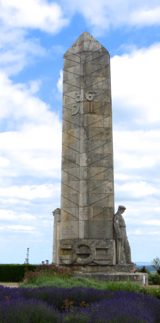 |
Chemin des Dames, Aisne, France | |
| A route famous in history, made infamous by World War I. | ||
|
|
|
The Chemin des Dames, or Ladies Road, is a stretch of road about 30 kilometers (19 miles) long, in the Aisne department, south of Laon and northeast of Soissons (map). It is best known today as the site of several important battles in World War I. But the road has a long history, because of its strategic location. Sitting atop a plateau between the Aisne and Ailette valleys, its height makes it an excellent lookout site. Over the years, a path was worn along the top as it was used as a lookout. The Battle of Craonne, in Napoléon's time, established its strategic importance. In the 18th century Louis XV had the road surfaced, not for military purposes, but rather to smooth the way for Adélaide and Victoire, to visit their friend (and the King's former mistress) at the Château de Boves, near Vauclair. Thus the route became known as the Chemin des Dames. Unfortunately, its use in World War I was far less romantic. The site of the First (1914), Second (1917) and Third (1918) Battles of the Aisne, it was witness to much action. An important part of the Western Front, the Chemin des Dames was fiercely contested, with great loss of life. It is estimated that during the Second Battle of the Aisne, which lasted about two weeks, there were over 270,000 French casualties and 160,000 German casualties. As a result, the Chemin des Dames today is lined with war memorials, monuments, and cemeteries. Tourists can drive down the road, stopping every few kilometers to see yet another memorial or burying ground. The most famous site along the Chemin des Dames is the Caverne du Dragon, a former quarry that became an underground barracks, supporting large communities of soldiers. You can visit these caves and get a sense of what it was like. More...
Driving along the Chemin des Dames, you are struck by the pastoral countryside and the sense of peace and calm. Despite this, farmers continue to find unexploded shells in their fields, and cows routinely have magnets in their stomachs that pick up the small bits of barbed wire that are all around the area; the magnets keep the metal from harming the cows. For the people who live there, the war's presence is not forgotten. Stops of interest along the Chemin des Dames include the Monument des Basques, a moving statue in memory of the 36th infantry division; the California Plateau, where you can see the remains of trenches; and the site of vieux Craonne, a village that was destroyed in 1914 (the new town of Craonne is nearby). The necropole nationale craonnelle, or national cemetery, with its rows of crosses is a sobering reminder of what happened here. The museum at the Caverne du Dragon provides guided tours of the caverne, and you can also check there for occasional tours of the Chemin des Dames and guided tours for the Malmaison Fort, at the western end of the Chemin des Dames.
|
|
|




